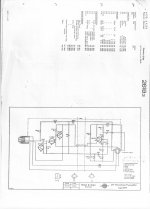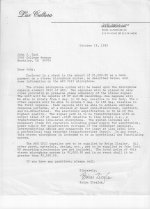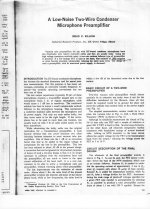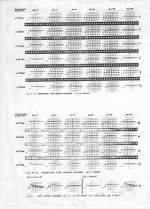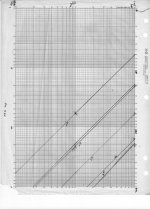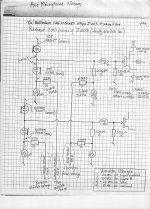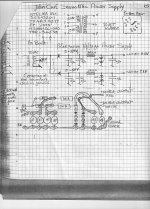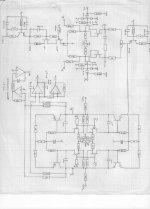Source was SACD, and we had selected music with lots of high freq content.
I'd hazard you preferred the relatively lower level of IMD hash with the filter in circuit - I know I would. SACD normally has ultrasonic output which compromises the dynamic range of downstream electronics.
Of course, you are so smart... and so modest !Scott did a good job. No more than I have done over the years with microphones, however.
I do remember that when I was around pro-audio live production microphones were selected based on their particular properties for each purpose. A mic for a drum head may have been different than one for the overhead cymbals and the same went for male and female vocals. But that was a part of the production process, just as a guitar player may like a certain type of distortion pedal like a phaser or a particular guitar head for a particular sound. I don't think anyone could tell Eric Clapton or someone like that they did not know what they were doing by using a particular amplifier or even a different tuned guitar for different songs. But that would be very different if you were recording an orchestra live than if you were doing a pop band or even a country and western band with fiddle. We do have to separate per-production from post-processing and reproduction. These are all very different pieces of the puzzle.
[snip]SACD normally has ultrasonic output which compromises the dynamic range of downstream electronics.
Yeah I've heard those old wives tales too
People have lots of imagination to rationalise what they *think* they hear/perceive.
jan
So Scott, you prefer microphones with audio FLAWS instead? '-)
Maybe you should ask Dick Marsh's friend Kavi Alexander (a real recording engineer) and the Grammys he has won with his custom old school all tube mics.
If you read my preface to part two of my article I make my position clear. I am not a recording engineer and make no claims on being able to apriori determine the "sound" of a recording from the technical measurements of the microphone.
BTW - B&K technology is sold to the audio market as DPA Microphones. I costs money to provide NIST traceable calibrations, hardly needed for a recording mic.
Last edited:
Scott did a good job. No more than I have done over the years with microphones, however. I don't see any breakthroughs here.
No claims of breakthrough were made except maybe how to DIY a pretty good 12dBA 1/2 inch mic for $100 that runs on a 9V battery for 100hr. The DPA equivalent capsule alone is $1,500, and that's at B&H I have no idea what the MSRP is. I would put the electrical alone performance of what I presented up against any commercial product. I stick to measured properties SNR, dynamic range, I leave the "voicing" to others.
Oh yes the optical photo-voltaic high voltage supply, no switching noise running on reused bias current not a breakthrough? There are those that disagree.
Last edited:
I was impressed -
Very excellent, high quality design work. Two thumbs up. Thank you. -RNMarsh
No claims of breakthrough were made except maybe how to DIY a pretty good 12dBA 1/2 inch mic for $100 that runs on a 9V battery for 100hr. The DPA equivalent capsule alone is $1,500, and that's at B&H I have no idea what the MSRP is. I would put the electrical alone performance of what I presented up against any commercial product. I stick to measured properties SNR, dynamic range, I leave the "voicing" to others.
Oh yes the optical photo-voltaic high voltage supply, no switching noise running on reused bias current not a breakthrough? There are those that disagree.
Very excellent, high quality design work. Two thumbs up. Thank you. -RNMarsh
Scott, I have in my closet a custom B&K 1'' microphone that I made for about the same amount of money. I paid $25 for the capsule gotten from a Lockheed auction in about 1968. I had someone machine an aluminum tube, and I designed the current source loaded follower with a 2N3819 or selected 2N4416, with 1G resistors, and with a VARIABLE bias, up to 200V, for making testing easier. That was 40 years ago.
You have added some interesting features since then, but no breakthrough's that I can see that either B&K or I could have used. Too bad the capsules are so expensive today. I have a couple of 1/2'' units and a couple of Sony C47 capsules that I would like to add electronics to, if I had the time and inclination. However, I don't record 'nature' and I don't work for the music makers anymore, so I live with other sources, and leave the capsules on the shelf. It is never any fun to do this sort of stuff (for me) when I do work that pays off that is so similar.
You have added some interesting features since then, but no breakthrough's that I can see that either B&K or I could have used. Too bad the capsules are so expensive today. I have a couple of 1/2'' units and a couple of Sony C47 capsules that I would like to add electronics to, if I had the time and inclination. However, I don't record 'nature' and I don't work for the music makers anymore, so I live with other sources, and leave the capsules on the shelf. It is never any fun to do this sort of stuff (for me) when I do work that pays off that is so similar.
Yes Richard, Scott's article was high quality and informative. However, it would not overexcite someone who has designed microphone electronics before, like B&K, or even me. That is why I usually don't comment openly on the articles published by Jan Didden. There is little to say, from my position on the different topics. The only REAL breakthrough that I have gotten from Jan's publication is from Ed Simon's input. Now he surprises me, sometimes. '-)
I hope that my inputs come through, but I must say that I have never seen Scott Wurcer's part 2 article that I presume came in Vol 3 of Jan's publication. When I contacted Jan at the SF AES, I chose the wrong Vol to get. I needed Vol 3, not Vol 4 that I already had. Jan, unfortunately, I am missing Vol 3 still.
Scott did a good job. No more than I have done over the years with microphones, however.
Maybe you did; maybe you didn't.
We will never know, will we?
I haven't seen you 'share' anything here beyond Electronics 101, Chapter 5, so I'm not holding my breath that you will reveal how a REAL mic preamp is done.
Though it would be great if you did...
BTW I'll send you a Vol 3.
jan
Jan, I really don't care, one way or another. Many here seem to forget that I was was directly involved in designing professional electronics fully 5 years before I started working with Mark Levinson. Even then, I kept my professional projects both in the USA and Europe for another 3 years. I never worked FOR Mark at any time. In that time, I assisted or designed analog tape recorders, servos, studio boards, line drivers, and even condenser microphone electronics, as well as power amps, etc, etc.
Of course, I did MY mike electronics, 40 years ago. It could use SOME updating.
Of course, I did MY mike electronics, 40 years ago. It could use SOME updating.
That's fine, but schematics and measurements say much more than words and WW2 stories. A mere statement how good you have been brings no useful information.
Indeed. Especially when stating that your design is as good as someone else's, and then state that you actually haven't seen that design. Very confidence-inspiring.
jan
OK, PMA Here is a little that I just got from my mike files. I have not found everything, but this should be a start.
Note that the microphone input RESISTORS of the B&K 2619 mike preamp are 200 meg ohms. THIS IS IMPORTANT.
NOTE the 1966 article by Mead Killion for the AES showing 1 G input resistors at mike input. Let's give credit where it is due!
Note that the microphone input RESISTORS of the B&K 2619 mike preamp are 200 meg ohms. THIS IS IMPORTANT.
NOTE the 1966 article by Mead Killion for the AES showing 1 G input resistors at mike input. Let's give credit where it is due!
Attachments
PMA, in truth, I am not here to GIVE you all my design knowledge, and you should not expect it, any more than I expect it from you. I appreciate what you have contributed here, however. You should feel the same about my contribution, and I am sorry that you don't. It is difficult to share with those who would potentially compete with me in the audio marketplace, you should know that. I think that it is enough that I care enough to contribute here and try to keep everyone learning something new.
- Status
- Not open for further replies.
- Home
- Member Areas
- The Lounge
- John Curl's Blowtorch preamplifier part II
